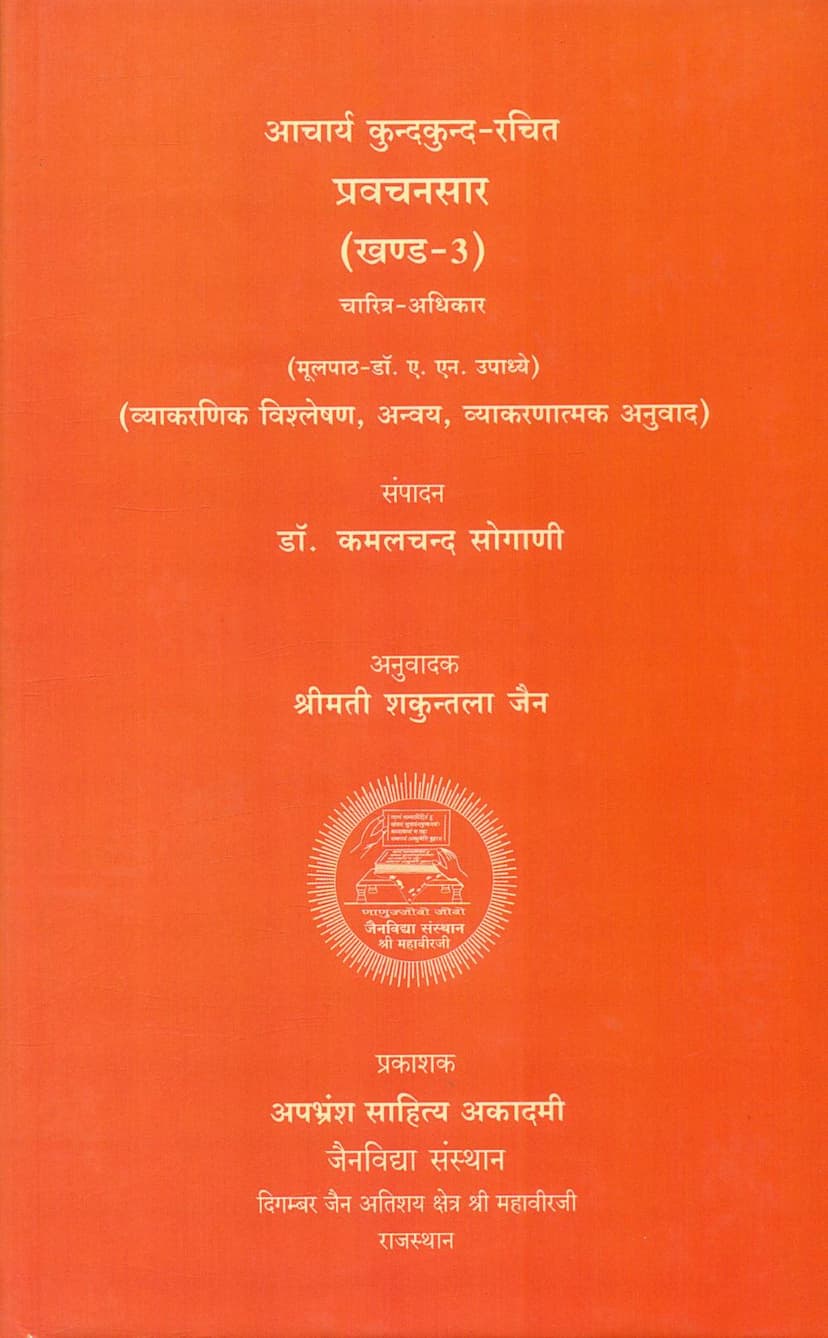Pravachansara Part 03
Added to library: September 2, 2025

Summary
Here's a comprehensive summary of the provided Jain text, "Pravachansara Part 03 - Charitra Adhikara" by Acharya Kundakunda, as presented in the given document:
This document is the third part of the "Pravachansara" text, specifically focusing on the Charitra Adhikara (Chapter on Conduct). It is a Hindi translation and analysis of the original work by Acharya Kundakunda, edited by Dr. Kamalchand Sogani and translated by Smt. Shakuntala Jain.
Overall Purpose of the Text:
The Charitra Adhikara delves into the essential principles and practices of a Jain monk (Shramana) on the path to liberation (Moksha). It outlines the conduct, vows, disciplines, and the mindset required for spiritual advancement.
Key Themes and Concepts Discussed:
- Renunciation of Possessions (Parigraha-tyaga) as the Core of Monkhood: Acharya Kundakunda emphasizes that the central pillar of a Shramana's life is the abandonment of possessions. Possessions lead to attachment and indiscipline, hindering the purity of the mind. Even holding onto the body itself requires a non-possessive attitude towards its actions. The body is seen as a vehicle for liberation, and its unnecessary adornment is discouraged.
- Importance of Agam Study and Faith in Principles: Without studying the Agamas (sacred scriptures), a Shramana cannot understand themselves or others. Agam study fosters concentration and leads to right faith (Samyagdarshan), which in turn guides conduct and discipline. Faith in the principles derived from Agams is crucial for spiritual progress.
- Types of Shramanas: Shubhopayogi and Shuddhopayogi: The text categorizes Shramanas into two types:
- Shubhopayogi Shramanas: These are those engaged in auspicious activities. Their conduct includes teaching, guiding disciples, and worshipping Jinendra (Tirthankaras). They extend compassionate help to householders and other monks. They are also permitted to interact with laypeople for appropriate reasons, such as attending to the sick, elderly, or young monks.
- Shuddhopayogi Shramanas: These are Shramanas whose focus is on pure meditation and self-realization. They have understood the essence of principles, renounced all internal and external possessions, and are not attached to sensory pleasures. They are described as being free from impurities and having completed their monastic practices.
- Shramana Initiation (Diksha): The text outlines the process of taking monastic initiation. It requires permission from family members, followed by acceptance from the Acharya. The 28 core observances (Mulas) for Shramanas are detailed, including:
- Five Great Vows (Mahavratas): Non-violence, Truthfulness, Non-stealing, Celibacy, Non-possession.
- Five Samitis (Careful Conduct): Vigilance in movement, speech, taking alms, placing and picking up objects, and excretion.
- Five Controls of the Senses: Sight, taste, smell, touch, and hearing.
- Six Essential Duties (Avashyakas): Equanimity (Samayika), Reverence (Vandana), Praise (Stuti), Confession/Repentance (Pratikraman), Self-Study (Svadhyaya), and Abandonment of the Body (Kayotsarga).
- Other Core Observances: Hair-plucking (Keshloch), Digambar (Nakedness), No bathing, Sleeping on the ground, No teeth-cleaning, Eating standing, Eating once a day.
- Inspiring Directions for Shramanas: The text stresses that a Shramana should not be attached to food, fasting, dwelling, wandering, the body, other monks, or frivolous talk. Carelessness in daily activities like sleeping, sitting, or walking is considered continuous violence. A Shramana should accept only minimal possessions necessary for discipline, which are not desired by undisciplined people and do not generate attachment.
- Mindfulness and Self-Control: A Shramana is described as being vigilant and restrained in mind, speech, and body. Control over the senses is paramount. One who has conquered passions and possesses right faith and knowledge is considered a true Shramana. Associating with worldly individuals is discouraged, even for someone who has mastered principles and undergone severe austeries.
- Qualities of a Perfect Shramana: Such a Shramana is indifferent to friends and foes, pleasure and pain, praise and blame, gold and dirt. They are equal in life and death. They are diligently engaged in right faith, right knowledge, and right conduct, and are focused on liberation.
- The Nature of the Monastic Garb (Ling): The monastic attire is described as being in accordance with one's birth, with hair plucked, free from bodily blemishes, and devoid of violence. It should be free from attachment and worldly activities, characterized by purity of consciousness and actions. It is the cause of liberation, and it should not be dependent on external validation.
- The Role of the Guru: The Guru is the one who bestows the monastic garb and initiates the disciple. Other monks are considered "Niryapak" who re-establish discipline when it is broken.
- Dealing with Lapse in Conduct (Chheda): If a monk errs in their actions or lapses in conduct, they must confess it and follow the guidance of the scriptures or a knowledgeable monk for penance.
- Importance of Proper Conduct in All Situations: Whether near or far from the Guru, a Shramana must remain free from lapses in conduct and constantly avoid attachments.
- The Role of Knowledge and Faith: A monk who is constantly engaged in self-reflection and knowledge and is mindful of their core vows attains perfect monkhood.
- Detachment from the World: A Shramana is unattached to worldly affairs and focused on the higher realm. They practice regulated eating and living and are free from passions.
- The Power of True Knowledge: An ignorant person may take many lifetimes to destroy karma, but a knowledgeable person, with control over mind, speech, and body, can achieve this in a single breath.
- The Ultimate Goal: The text underscores that even possessing vast scriptural knowledge is insufficient for liberation if there is even a particle of attachment to the body or worldly things. True liberation comes from purity of mind and detachment.
In essence, "Pravachansara Part 03 - Charitra Adhikara" provides a profound guide to the ethical and spiritual discipline of a Jain monk, emphasizing renunciation, self-control, scriptural study, and unwavering devotion to the path of liberation.